ShopDreamUp AI ArtDreamUp
Deviation Actions
When it comes to real-world hardware or designed but never flown air and spacecraft or questions about propulsion systems real or theoretical aerospace engineer and spaceflight historian Scott Lowther, author of Aerospace Projects Review, is a bona fide authority.
I consider technical drawings to be an art form, art raised to an exacting level of precision, and Scott is a master of the craft.
In Aerospace Projects Review issue Volume 2, Number 2, available here Scott offers a beautifully illustrated 56-page article on Project Orion. This is one of the most definitive articles on the subject, covering the large designs, 20 meters and diameter and larger. The 4,000 ton nuclear pulse propulsion orbital battleship design for the USAF is shown in never-before-published detail. Scott was able to interview one of the surviving members of the original General Atomics Orion team, this issue contains details unavailable elsewhere and is highly recommended.
Scott was kind enough to provide these illustrations for purposes of this feature, pick up APR issue Volume 2, Number 2 at the link above to view these (and many, many more) diagrams in glorious full hi-resolution detail. Aerospace Projects Review offers an entire series on Orion, each article beautifully illustrated and packed with information unavailable elsewhere, see the links below.
USAF Orion Battleship Interior Detail
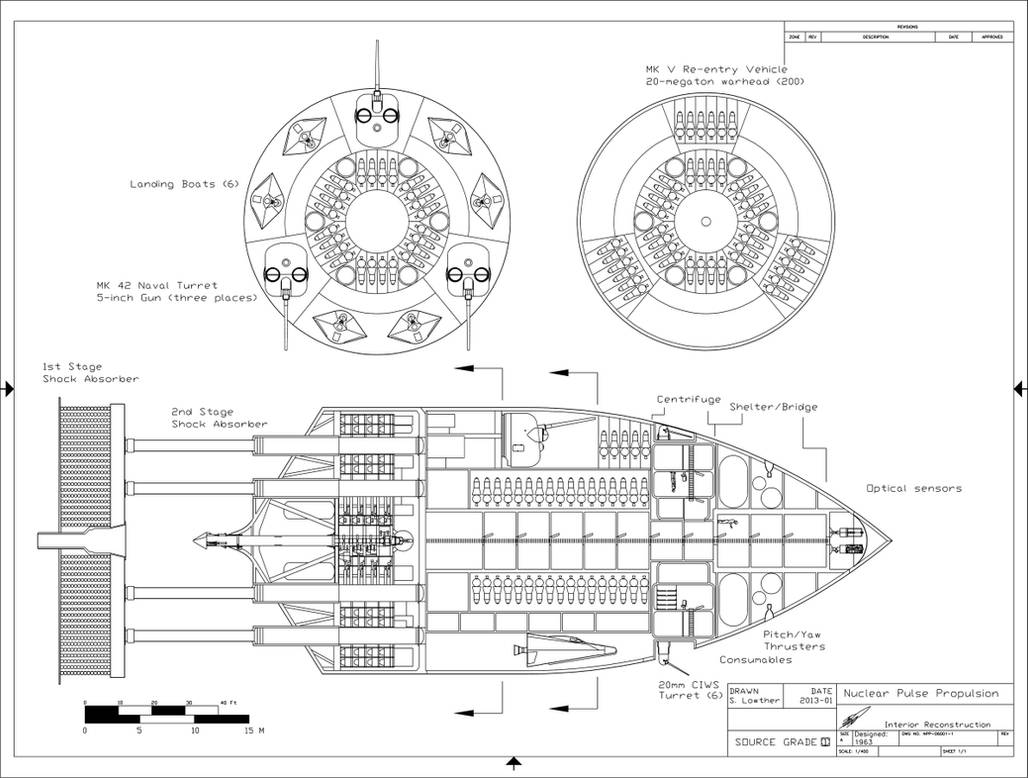
USAF Orion Battleship Exterior
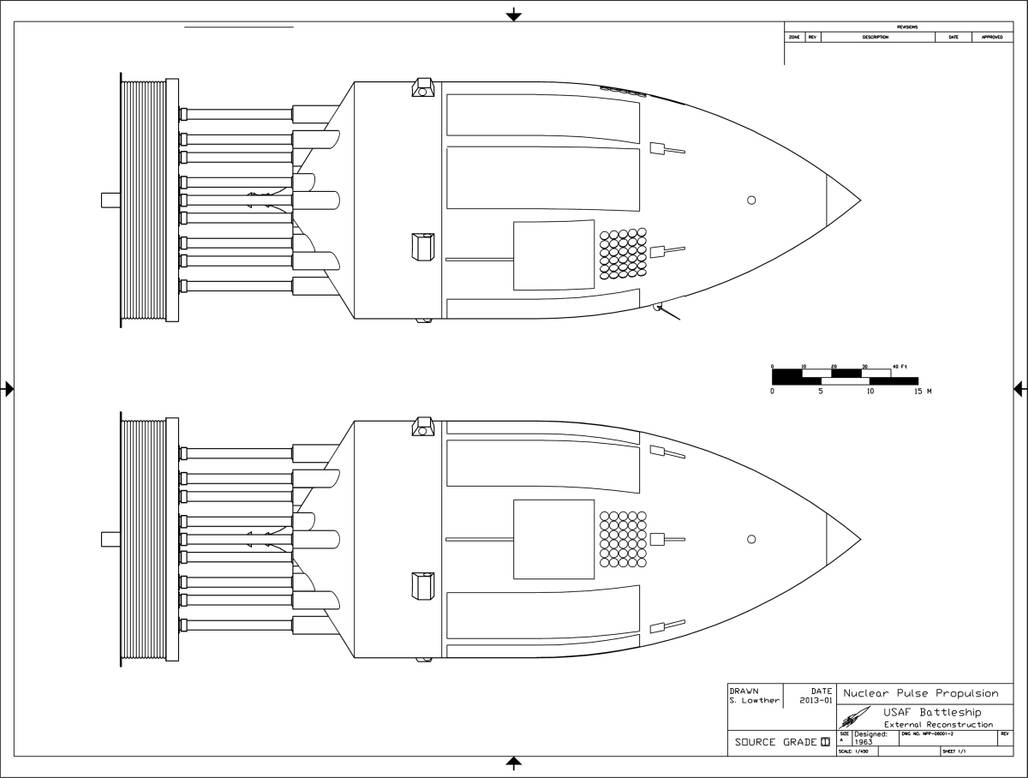
One scheme for lofting the Orion involved launching it atop a Convair Nexus booster.
4,000 Ton Orion and Nexus Booster
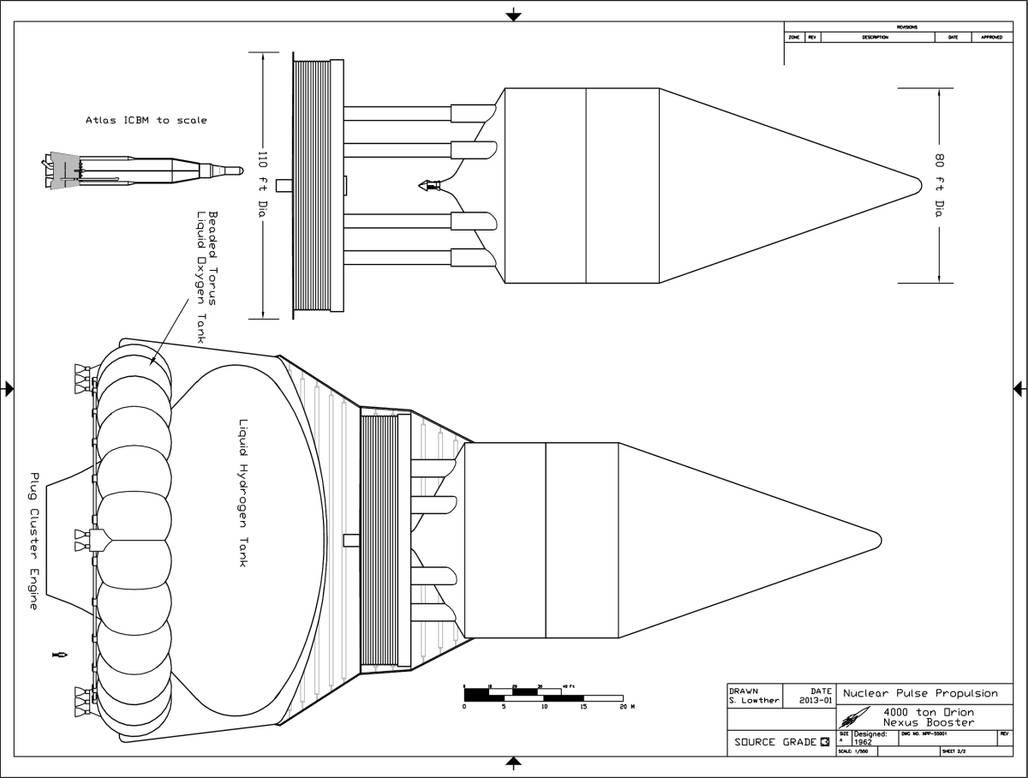
Orion and Nexus Booster/Saturn V Scale Comparison
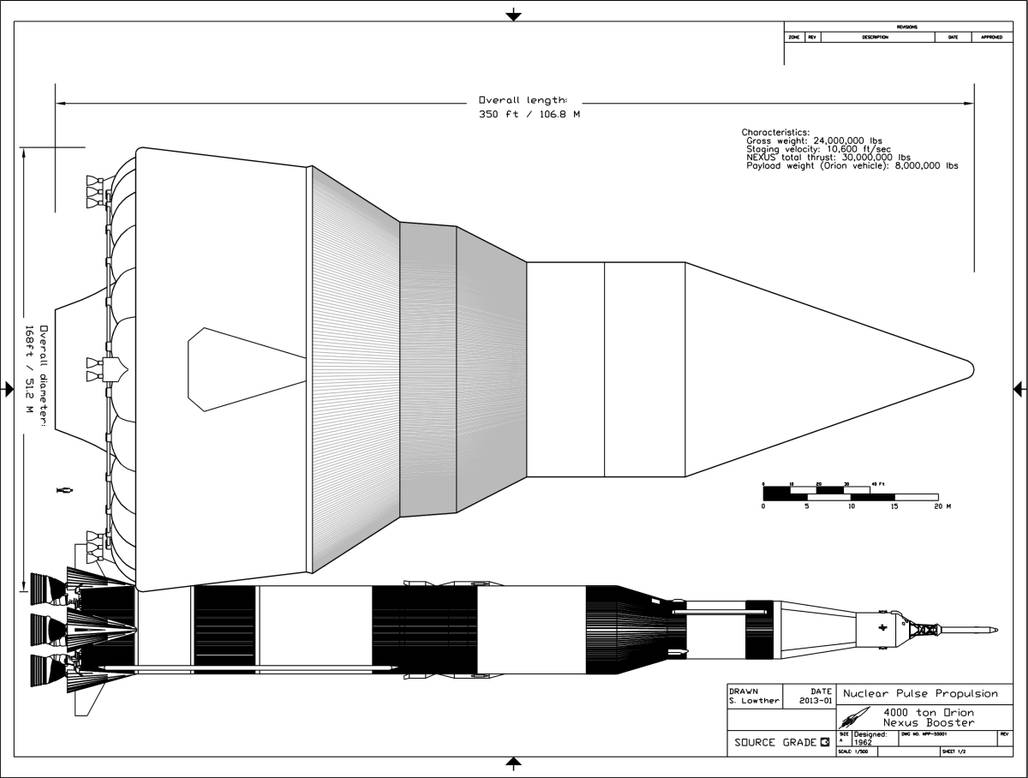
The Nexus booster was a “plastic” design in the sense it could be stretched or compressed, scalable to accommodate a large range of payload sizes and weights.
Aerospace Projects Review, Issue Volume 3, Number 1 contains an in depth article on the Convair Nexus super-booster from 1963/64, available here.
See my 3D Convair Nexus models based on Scott Lowther’s diagrams, here, here, and here.
A few years back Scott started work on Nuclear Pulse Propulsion, which is to be the comprehensive tome on the subject, he had the idea to include a short fiction on the Orion Battleship to bring the concept to life in the mind of the reader, the result is a rough-draft short tale of Orion orbital Battleships going full-commitment against Soviet forces. Scott is presently considering developing the work into a full fledged novel.
In Scotts words: "This is planned to be an official history, with the (tentative, subject to change) title: “Pax Orionis: A History of the Third World War and Its Aftermath.” Written in the alternate history 2014, it focuses on nuclear pulse propulsion, how it began in the fifties, turned into a reality as a result of a small nuclear war in the sixties and became a dominant force in geopolitics until the Third World War in the 1990′s (currently scheduled for 1994, so the book is a “20th anniversary” thing). This alternate world is quite a different place due to some very small changes that quickly spiral into massive consequences. WW III is as bad as it gets; somewhere in the history will be population tables from before the war, right after and as of 2014, with discussions of the possibility that within the next X years the planetary population might make it back up to one billion. But on the other side, the war leaves translunar and interplanetary infrastructure largely intact; while Earth is trashed, the universe is now open and the ships are there."
Scott has made a rough draft of the opening-of-battle scene, which is available free of charge here.
One additional short scene concerning development of a low-cost, near-fission-free bomb, written in television script format, is available here Things Blow Up.
Frankly I’d love to read this novel, so I encourage everyone to download and read the sample scenes, even in rough-draft form this promises to be epic.
The Doomsday Orion
One notational 1959 concept for a large military Orion was the “doomsday weapon” idea. This was to be an Orion equipped with one single weapon, a hydrogen bomb of immense size and capability. While the data is sketchy, the payload would be a single nuclear device with a mass of 1,650 tons. Yield is not readily available, but is estimatable. Assuming 5 megatons per ton from a highly efficient nearly pure fusion lithium deuteride device yields 8,250 megatons, or 8.25 gigatons.
Doomsday Orion
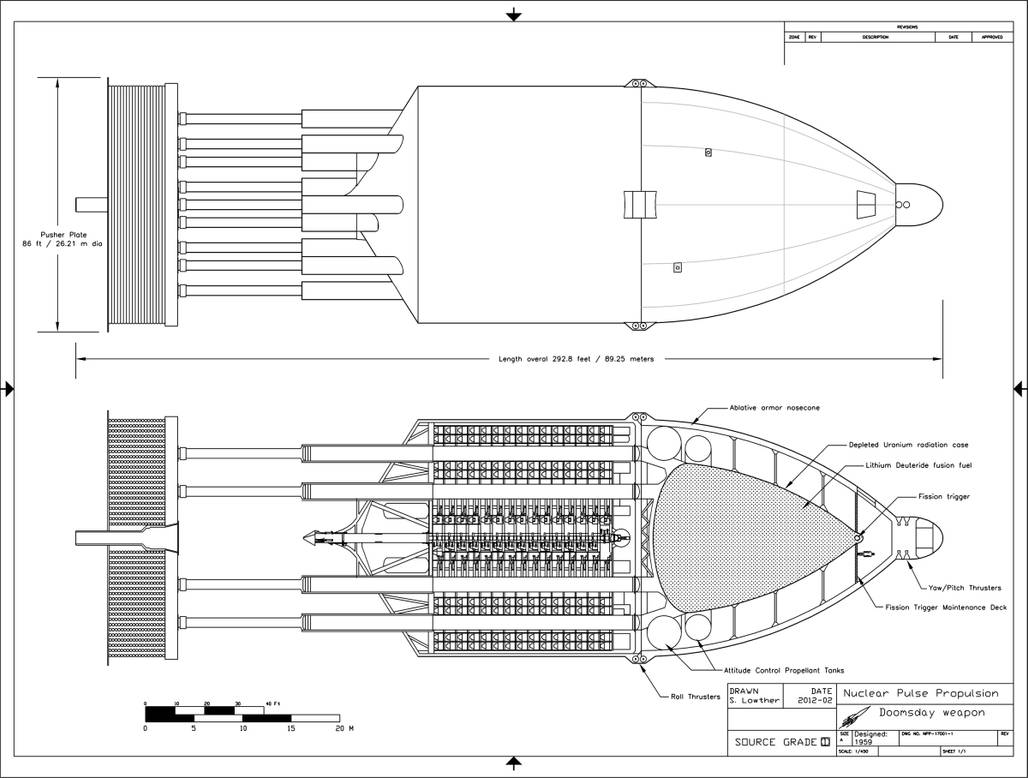
Such a weapon would of course be a last ditch weapon to be used when the United States was threatened with extermination. Needless to say, such a device detonated in low Earth orbit would devastate a large area of the Earth’s surface. The damage would come in the form of high energy radiation rather than blast. Scott observes that weapons of this size were so far beyond contemporary understanding no one really knew exactly what would happen if the bomb were touched off. Would the high energy radiation simply sleet through the atmosphere being absorbed in the ground or structures, or would it be absorbed in the upper atmosphere heating it well beyond incandescence … essentially setting the sky on fire? Whatever the effects were, they would be spread over most of a hemisphere.
Aerospace Project Review, The Project Orion Issues
Aerospace Projects Review issue Volume 1, Number 4 V1N4
The primary article in this issue is a 58-page article on the development of Project Orion. This article covers the initial development of Project Orion, from the earliest configurations through to the near-final designs, test facilities, safety and environmental issues, and subscale flight vehicles. Vehicle scaling relationships, operating principles, and, published for the first time, pulse unit physics and interactions.
Copiously illustrated with photos, film stills, presentation graphics, diagrams and original drawings.
Aerospace Projects Review issue Volume 1, Number 5 V1N5
The primary article in this issue is a 71-page article on the late 10-meter Project Orion vehicles designed for the USAF and NASA by General Atomic. This article is packed with diagrams taken from official reports, as well as data, performance graphs, all-new reconstruction drawings and artwork. The Orion vehicle is described and shown in greater detail here than ever before in publicly available articles. Also includes information on 8-meter and 12-meter concepts for military applications as well as the baseline 10-meter design that was to serve both military and Martian exploration purposes. Launch vehicles, both solid and liquid rockets, are also described.
Aerospace Projects Review issue Volume 1, Number 3 V1N3
The Helios program: contained nuclear-pulse propulsion program, run parallel with Orion, specifically the ideas of Dandridge Cole and Project Helios. This is the first part in a series on the Orion Project. Included are full-color reproductions of period artwork as well as all-new reconstructions of the designs.
Project Orion Links: Artwork, Journal posts, and Winchell Chung's Atomic Rocket Site
My 10-meter NASA Orion 3D models
Orion In Flight
On Orbit
My journal entry: Orion: Nuclear Pulse Propulsion.
Winchell Chung’s Atomic Rockets site Orion page.
Winchell Chung’s Orion Battleship Page.
General Atomics NASA report on Orion, PDF: GA-5009 vol III "Nuclear Pulse Space Vehicle Study - Conceptual Vehicle Design" by General Atomics (1964).
I consider technical drawings to be an art form, art raised to an exacting level of precision, and Scott is a master of the craft.
In Aerospace Projects Review issue Volume 2, Number 2, available here Scott offers a beautifully illustrated 56-page article on Project Orion. This is one of the most definitive articles on the subject, covering the large designs, 20 meters and diameter and larger. The 4,000 ton nuclear pulse propulsion orbital battleship design for the USAF is shown in never-before-published detail. Scott was able to interview one of the surviving members of the original General Atomics Orion team, this issue contains details unavailable elsewhere and is highly recommended.
Scott was kind enough to provide these illustrations for purposes of this feature, pick up APR issue Volume 2, Number 2 at the link above to view these (and many, many more) diagrams in glorious full hi-resolution detail. Aerospace Projects Review offers an entire series on Orion, each article beautifully illustrated and packed with information unavailable elsewhere, see the links below.
USAF Orion Battleship Interior Detail

USAF Orion Battleship Exterior

One scheme for lofting the Orion involved launching it atop a Convair Nexus booster.
4,000 Ton Orion and Nexus Booster

Orion and Nexus Booster/Saturn V Scale Comparison

The Nexus booster was a “plastic” design in the sense it could be stretched or compressed, scalable to accommodate a large range of payload sizes and weights.
Aerospace Projects Review, Issue Volume 3, Number 1 contains an in depth article on the Convair Nexus super-booster from 1963/64, available here.
See my 3D Convair Nexus models based on Scott Lowther’s diagrams, here, here, and here.
A few years back Scott started work on Nuclear Pulse Propulsion, which is to be the comprehensive tome on the subject, he had the idea to include a short fiction on the Orion Battleship to bring the concept to life in the mind of the reader, the result is a rough-draft short tale of Orion orbital Battleships going full-commitment against Soviet forces. Scott is presently considering developing the work into a full fledged novel.
In Scotts words: "This is planned to be an official history, with the (tentative, subject to change) title: “Pax Orionis: A History of the Third World War and Its Aftermath.” Written in the alternate history 2014, it focuses on nuclear pulse propulsion, how it began in the fifties, turned into a reality as a result of a small nuclear war in the sixties and became a dominant force in geopolitics until the Third World War in the 1990′s (currently scheduled for 1994, so the book is a “20th anniversary” thing). This alternate world is quite a different place due to some very small changes that quickly spiral into massive consequences. WW III is as bad as it gets; somewhere in the history will be population tables from before the war, right after and as of 2014, with discussions of the possibility that within the next X years the planetary population might make it back up to one billion. But on the other side, the war leaves translunar and interplanetary infrastructure largely intact; while Earth is trashed, the universe is now open and the ships are there."
Scott has made a rough draft of the opening-of-battle scene, which is available free of charge here.
One additional short scene concerning development of a low-cost, near-fission-free bomb, written in television script format, is available here Things Blow Up.
Frankly I’d love to read this novel, so I encourage everyone to download and read the sample scenes, even in rough-draft form this promises to be epic.
The Doomsday Orion
One notational 1959 concept for a large military Orion was the “doomsday weapon” idea. This was to be an Orion equipped with one single weapon, a hydrogen bomb of immense size and capability. While the data is sketchy, the payload would be a single nuclear device with a mass of 1,650 tons. Yield is not readily available, but is estimatable. Assuming 5 megatons per ton from a highly efficient nearly pure fusion lithium deuteride device yields 8,250 megatons, or 8.25 gigatons.
Doomsday Orion

Such a weapon would of course be a last ditch weapon to be used when the United States was threatened with extermination. Needless to say, such a device detonated in low Earth orbit would devastate a large area of the Earth’s surface. The damage would come in the form of high energy radiation rather than blast. Scott observes that weapons of this size were so far beyond contemporary understanding no one really knew exactly what would happen if the bomb were touched off. Would the high energy radiation simply sleet through the atmosphere being absorbed in the ground or structures, or would it be absorbed in the upper atmosphere heating it well beyond incandescence … essentially setting the sky on fire? Whatever the effects were, they would be spread over most of a hemisphere.
Aerospace Project Review, The Project Orion Issues
Aerospace Projects Review issue Volume 1, Number 4 V1N4
The primary article in this issue is a 58-page article on the development of Project Orion. This article covers the initial development of Project Orion, from the earliest configurations through to the near-final designs, test facilities, safety and environmental issues, and subscale flight vehicles. Vehicle scaling relationships, operating principles, and, published for the first time, pulse unit physics and interactions.
Copiously illustrated with photos, film stills, presentation graphics, diagrams and original drawings.
Aerospace Projects Review issue Volume 1, Number 5 V1N5
The primary article in this issue is a 71-page article on the late 10-meter Project Orion vehicles designed for the USAF and NASA by General Atomic. This article is packed with diagrams taken from official reports, as well as data, performance graphs, all-new reconstruction drawings and artwork. The Orion vehicle is described and shown in greater detail here than ever before in publicly available articles. Also includes information on 8-meter and 12-meter concepts for military applications as well as the baseline 10-meter design that was to serve both military and Martian exploration purposes. Launch vehicles, both solid and liquid rockets, are also described.
Aerospace Projects Review issue Volume 1, Number 3 V1N3
The Helios program: contained nuclear-pulse propulsion program, run parallel with Orion, specifically the ideas of Dandridge Cole and Project Helios. This is the first part in a series on the Orion Project. Included are full-color reproductions of period artwork as well as all-new reconstructions of the designs.
Project Orion Links: Artwork, Journal posts, and Winchell Chung's Atomic Rocket Site
My 10-meter NASA Orion 3D models
Orion In Flight
On Orbit
My journal entry: Orion: Nuclear Pulse Propulsion.
Winchell Chung’s Atomic Rockets site Orion page.
Winchell Chung’s Orion Battleship Page.
General Atomics NASA report on Orion, PDF: GA-5009 vol III "Nuclear Pulse Space Vehicle Study - Conceptual Vehicle Design" by General Atomics (1964).
SpaceX Return to Flight -Iridium Flight 1
SpaceX returns to flight with a picture perfect launch and first stage landing on the autonomous drone ship "Just Read The Instructions."
Today's launch lofted 10 Iridium NEXT satellites into orbit on the first flight for Iridium of a planned 8 launches.
Today's successful landing marks the first Falcon 9 to touch down on drone ship "Just Read The Instructions." and the seventh successful Falcon 9 first stage landing.
Project Orion The USAF Plan 1962
Dr. Brent Ziarnick, Major, USAFR, gives an excellent talk on Orion and the role it might have played as part of the US strategic nuclear forces.
The engineering and physics side of nuclear pulse propulsion has been covered in great detail through declassified documents such as the General Atomics report on Orion, which can be found here: GA-5009 vol III "Nuclear Pulse Space Vehicle Study Conceptual Vehicle Design" and George Dyson's book,* which is an essential study guide to Orion, detail on the USAF side of Project Orion is still emerging. This video provides an in depth look at the scope of those plans.
*George Dyson's book can be found
National Geographic: Mars
This is a good watch, near future hard SF with well placed documentary style interviews. The first episode streams free at the National Geographic site linked, and can also be found on Hulu.
Video at the link: Mars: Novo Mundo
Constellation Program NTR Mars Mission Animation
Human Exploration of Mars Design Reference Architecture (DRA) 5.0
The other day my friend f r a g o m a t i k shared this link to a stunning video animation of the (canceled) Constellation program nuclear thermal Mars mission.
The nine minute long animation depicts NASA Design Reference Architecture (DRA) 5.0 Constellation program 7-launch nuclear thermal Mars mission strategy.
You can download the PDF here: Human Exploration of Mars Design Reference Architecture (DRA) 5.0
View the animation here: Mars Mission animation
Abstract
DRA 5.0 features a long surface stay “split mission” using separate cargo and crewed Mars transfe
Featured in Groups
© 2015 - 2024 William-Black
Comments15
Join the community to add your comment. Already a deviant? Log In
Do you have any info on the landing boats?
